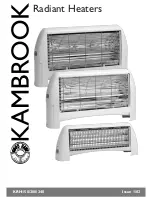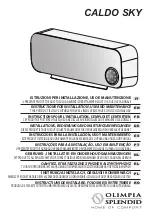
14
1. Seal any unused openings in the common
venting system.
2. Visually inspect the venting system for
proper size and horizontal pitch to determine if
there is blockage, leakage, corrosion or other
deficiencies that could cause an unsafe
condition.
3. If practical, close all building doors, windows
and doors between the space in which the
appliance remains connected to the common
venting system and other spaces in the
building. Turn on clothes dryers and any
appliances not connected to the common
venting system. Turn on any exhaust fans,
such as range hoods and bathroom exhausts,
at maximum speed. Do not operate a summer
exhaust fan. Close all fireplace dampers.
4. Place in operation the appliance being
inspected. Follow the lighting instructions.
Adjust the thermostat so the appliance will
operate continuously.
5. Test for spillage at the draft hood relief opening after 5 minutes of main burner operation. Use the
flame of a match or candle or smoke from a cigarette.
6. After it has been determined that each appliance remaining connected to common venting system
properly vents when tested as outlined, return doors, windows, exhaust fans, fireplace dampers and any
other gas burning appliance to their previous condition of use.
7. Any improper operation of the common venting system should be corrected to conform to the National
Fuel Gas Code, ANSI Z223.1. When resizing any portion of the common venting system, the system
should approach the minimum size as determined using the appropriate tables in Appendix G in the
National Fuel Gas Code, ANSI Z 223.1.
H. WATER CHEMISTRY
Chemical imbalance of your water can cause severe damage to your water heater and associated
equipment, and may also affect efficiency. You may have to have your water quality professionally
analyzed to determine whether you need to install a water softener. It is important that the water
chemistry on both the domestic hot water and central heating sides are checked before installing the
heater, as water quality will affect the reliability of the system.
Outlined below are those water quality parameters which need to be met in order for the system to
operate efficiently for many years.
Failure of a heat exchanger due to lime scale build-up on the
heating surface, low pH or other imbalance IS NOT covered by the warranty.
Water Hardness
Water hardness is mainly due to the presence of calcium and magnesium salts dissolved in the water.
The concentration of these salts is expressed in mg/L, ppm or grains per gallon, as a measure of relative
hardness of water. Grains per gallon is the common reference measurement used in the U.S. water
Figure 2
Summary of Contents for Versa Hydro PHE130-119
Page 23: ...23 Figure 5 Figure 6 ...
Page 24: ...24 Figure 7 ...
Page 25: ...25 F HYDRONIC PIPING Figure 8 ...
Page 26: ...26 Figure 9 ...
Page 27: ...27 Figure 10 ...
Page 28: ...28 Figure 11 ...
Page 29: ...29 Figure 12 ...
Page 32: ...32 F INTERNAL WIRING Figure 14 Internal connection diagram ...
Page 38: ...38 Figure 17 ...
Page 48: ...48 Figure 25 ...
Page 76: ...76 Figure 29 ...
Page 77: ...77 Figure 30 ...
Page 78: ...78 Figure 31 LP 314 G ...
Page 79: ...79 Figure 32 ...
Page 81: ...81 ...
Page 82: ...82 ...
Page 83: ...83 MAINTENANCE NOTES ...















































